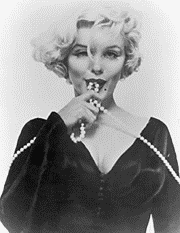THE BREAKOUT PERFORMANCE in Howard Hawks’ 1959 Rio Bravo came from a leggy, auburn-haired actress named Angie Dickinson. Running into Hawks years later, her tresses now bleached, Dickinson mentioned that she’d always hoped to do another picture with him. “I liked your hair dark better,” the director of Gentlemen Prefer Blondes replied, and that was the end of the conversation.
SUMMER BLONDES
with Marilyn Monroe, Jean Harlow, Mae West, Marlene Dietrich, Lana Turner, Kim Novak, and Jayne Mansfield
runs July 21-August 19 at Grand Illusion
Since his films often featured strong female roles, Hawks perhaps valued individual actresses over the “types” that the Hollywood studio system groomed and promoted. Foremost among these types was the gilded sex symbol, the subject of this seven-film, five-week retrospective. The blonde goddess archetype originated on screen in the ’30s, becoming more overtly sexual before fading in the early ’60s as social mores liberalized and the studios’ contract system died. Actresses who defied stereotyping often met career obstacles and personal tragedy—Marilyn Monroe being the most spectacular example in a line from Jean Harlow to Jayne Mansfield.
In the early days, shocking the audience was easier. Female stars didn’t have to reveal much flesh; they just donned men’s clothing like Marlene Dietrich and Mae West (whose early burlesque act included male impersonation). Dietrich’s husky accent and androgynous allure projected an exoticism not usually found in Hollywood blondes. West’s sexually voracious persona was threatening in a different way. Both actresses seemed dangerously capable of appropriating power.
The American worship of fair-haired starlets also included an implicitly racist element. In 1932’s Blonde Venus, Dietrich dons a blonde-afro wig for a ridiculous musical number involving a gorilla and chorus girls in sequins and face paint; later, reduced to prostitution, she still remains one rung up on the social ladder from her black maid. Red Dust (1932) with platinum-haired Harlow also playing a prostitute, depicts an Indochina rubber plantation where Clark Gable complains incessantly about “lazy coolies” and the native houseboy is a grinning caricature. In both films, blondeness sets the heroine above the darkly primitive, yet also links her to untamable Nature.
Harlow, another wisecracking, sexually forthright blonde like West, had her career cut short by a tempestuous, tragic personal life, but the ’40s saw her replacement model, the equally woeful Lana Turner (Johnny Eager, 1942), who never clicked with audiences despite her pin-up success.
The ’50s, of course, celebrated an overripe blonde sexuality, embodied by Monroe (The Seven Year Itch, 1955), then caricatured by Mansfield (The Girl Can’t Help It, 1956). Such lushness practically guaranteed a backlash, represented by Kim Novak (Boys’ Night Out, 1962).
In film, as much as any medium, the most creative endeavors often occur under the most repressive constraints. Ironically, now that the studios’ control is limited, the golden cinema goddess has disappeared altogether—along with the dumb blonde stereotype. (Check out Cameron Diaz as brain surgeon in There’s Something About Mary.) Actresses change their hair color at whim. Meanwhile, the prefab platinum icons of the past remain immortalized on screen, their pathos inseparable from their mystique.






